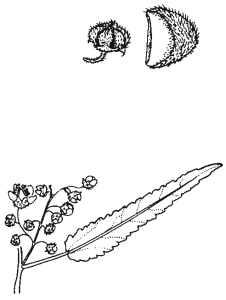Family:
Malvaceae
Gynatrix pulchella
Hempbush
(syn: Plagianthus pulchellus; P. pulchellus var. tomentosus)
Other Names: Common Hempbush
First Nations Name(s):

Name Origin:
pulchella — from Latin pulchella, beautiful.
Regional Subspecies:
Occurrence:
Regional:
Noted in Tumut region.
Australia:
NSW, Vic, Tas.
Habitat:
Chiefly in gully scrubs and near creeks on rocky sites, at moderate elevations.
Habit:
Semi-deciduous, open woody spreading shrub to 3 m high. Bright green heart-shaped, soft, toothed leaves to 15 cm long.
Site Preference:
Protected position in moist, well-drained soil and semi-shade. Tolerates poor drainage and seasonal waterlogging to 10 cm deep, and full sun. Tolerates extended dry periods but not permanently dry soil. Tolerates moderate frost.
Flowering:
Cream to white. Often profuse and fragrant, in loose clusters along stems.
Seed Collection:
Late Nov to late Dec. Monitor closely as seeds shed 3-14 days after maturity. Seeds remain viable for at least 2 years.
Propagation:
From seed or cuttings. Seeds germinate readily in 2-4 weeks, and can be direct seeded into pots (2 seeds per pot). Strikes readily from cuttings.
Regeneration:
Regenerates readily in disturbed areas.
VALUES:
Land Protection:
Useful for stabilising soils along creeks where it occurs naturally.
First Nations:
String made from bark.
Ornamental:
Not highly ornamental, but attractive when flowering profusely. Fragrant floral perfume can permeate large areas. Can be planted under established trees. Prune tips to encourage bushiness and prevent straggliness. Cultivated plants may be short-lived.
Other:
Good quality warp yarn produced from bark in 19th century.
